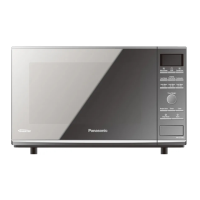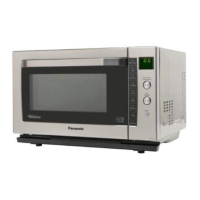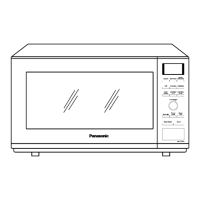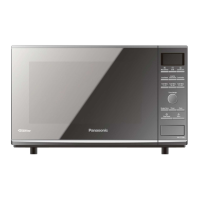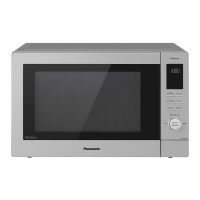Do you have a question about the Panasonic NN-CF760M and is the answer not in the manual?
Table of weight conversions from ounces to grams.
Table of capacity conversions from pints/quarts to ml/litres.
Explanation of the microwave symbol and heating category.
Notes on matching oven voltage and potential hazards of higher voltage.
Warning about hot exterior surfaces and interior heating elements during operation.
Guidance on keeping children away from the oven and supervision due to heat.
Instructions to unpack and check the oven for damage before installation.
Instructions for replacing a damaged power cord.
Guidelines for placing the oven on a stable surface with proper airflow clearances.
Advice on contacting service for repairs and hazards of unauthorized service.
Instructions for the initial burn-off cycle for convection/grill functions.
Guidance on cleaning the interior, door seals, and using mild detergent.
Cleaning the control panel with a dry cloth and leaving the door open.
Usage guidelines for the wire shelf in different cooking modes.
Usage guidelines for the enamel shelf, emphasizing limitations.
Actions to take in case of smoke or fire.
Importance of not exceeding cooking times and adjusting based on factors.
Caution against heating liquids in sealed containers and preventing boil-overs.
Instruction to remove lids before microwaving to prevent explosions.
Prohibition of attempting deep fat frying in the oven.
Importance of regular cleaning for safe operation and how to clean.
Explanation of arcing and actions to take if it occurs.
Explanation of how microwaves heat food through water molecule vibration.
Warning that dishes get warm and oven gloves are required.
Warning against heating eggs in their shells due to explosion risk.
Explains standing time and lists specific foods and their standing times.
Instruction to pierce skins to allow steam escape and avoid bursting.
Importance of checking food during and after cooking.
General advice on keeping the oven clean.
A test to check if a dish is suitable for microwave cooking.
How to use foil/metal containers and when not to use them.
Guidelines for using plastic containers and restrictions.
Guidelines for using aluminium foil for shielding and cautions.
Prohibition of using these materials in the microwave.
Function of the display window.
Function of the microwave power button.
Function of the grill button.
Function of the convection button.
Function of the auto weight defrost buttons.
Function of the auto weight programs button.
Function of the time/weight dial.
Function of the memory button.
Function of the timer button for delay start, timer, and clock setting.
Function of the clock button.
Function of the stop/cancel button.
Function of the start button.
Instruction to plug into a socket.
Steps to set the clock.
Instructions for the initial convection oven burn-off.
How to operate and clear the child lock facility.
Step-by-step guide to set the clock.
Table of power levels and their wattages.
Table of defrost programs, weight ranges, and suitable foods.
General tips for defrosting, including checking, turning, shielding, and standing time.
Chart detailing defrosting times, weights, methods, and standing times for various meat items.
Step-by-step instructions for setting a standing time.
Step-by-step instructions for setting a delayed start time.
Instructions for programming cooking methods into memory.
Warning about hot accessories and oven surfaces.
Key guidelines for grilling, including not covering food and using oven gloves.
Warning about hot accessories and oven surfaces.
Notes on using standard metal tins and placing large joints.
Strong caution about hot items and proper handling.
A table mapping Celsius temperatures to Fahrenheit and Gas Marks for various uses.
Warning about hot accessories and oven surfaces.
Advice on preheating and not using plastic containers.
A specific restriction on using the enamel shelf.
Restrictions on plastic containers and suitability of heatproof glass.
Warning about hot items and handling.
Minimum food quantity requirement for this program.
Specific restriction on enamel shelf.
Notes on cooking uncovered and cleaning accessories.
Warning about hot items and handling.
Minimum food quantity requirement.
Reiterates restriction on enamel shelf.
Notes on cooking uncovered and cleaning.
Warning about hot items and handling.
Minimum food quantity requirement.
Reiterates restriction on enamel shelf.
Notes on cooking uncovered.
Minimum food quantity requirement.
Warning about hot items and handling.
Explanation of symbols indicating cooking mode and accessories.
Rules for using auto weight programs, including weight ranges and checking food.
Table listing min/max weights for auto weight programs.
Instructions for cooking fresh vegetables using auto program.
Instructions for cooking frozen vegetables using auto program.
Instructions for cooking fresh fish using auto program.
Instructions for cooking breaded fish using auto program.
Instructions for cooking whole chicken using auto program.
How to determine if food is reheated (piping hot).
How to check if unstirred foods are heated.
Caution against overheating mince pies due to filling temperature.
Safety precautions for heating baby bottles and the microwave's unsuitability for sterilizing.
Detailed safety instructions for heating baby bottles.
Advice on checking food for piping hot temperature after reheating.
Cooking instructions for bacon and pork with safety warnings.
Guidelines for cooking beans and pulses, including pre-soaking and boiling time.
Cooking instructions for beef with safety warnings and temperature guidelines.
Cooking instructions for chicken with safety warnings.
Cooking instructions for fresh fish.
Cooking instructions for game with safety warnings.
Cooking instructions for lamb with safety warnings.
How to adjust recipes for more servings.
How to adjust recipes for fewer servings.
Guidance on adapting recipes from other cookbooks for this oven.
Importance of checking food during cooking for single servings.
How to tell when fish is cooked.
Advice on thawing and standing defrosted meat joints.
Minimum standing times for meat and poultry.
Guidelines for cooking jacket potatoes by microwave.
Steps to prepare potatoes before microwave cooking.
Recipe for Spicy Tomato Pasta.
Recipe for Cheese & Red Pesto Tarlets.
Cautions regarding the use of wooden spoons.
Importance of using large bowls for preserves and not leaving unattended.
A specific prohibition for preserving jars.
Recipe for Shortcrust Pastry.
Recipe for Minced Beef and Onion Pie.
Recipe for Apple Pie.
Recipe for Baked Jam Roly Poly Pudding.
Recipe for Lemon Meringue Pie.
Recipe for Apple Strudel.
Recipe for Creamy Rice Pudding.
Recipe for Syrup Sponge Pudding.
Recipe for Eve's Pudding.
Recipe for Crème Caramel.
Recipe for Bread & Butter Pudding.
Recipe for Fruit Crumble.
Recipe for Christmas Pudding.
Recipe for Celebration Cake.
Recipe for Chocolate Cake.
Recipe for Fruity Cream-Cheese Cake.
Recipe for Banana Cake.
Recipe for Coffee and Walnut Cake.
Recipe for Pecan Sour Cream Cake.
Recipe for Boiled Fruit Cake.
Recipe for American Cookies.
Recipe for Chocolate Brownies.
Recipe for Streusel Topped Fruit Muffins.
How to prove dough using convection at 40°C.
Ingredients and method for standard and wholemeal bread.
Recipe for Focaccia.
Recipe for Pizza Alle Cipole.
Cause of smoke and odour from oven vents.
Warning about placement above conventional cookers.
Maximum input power and power consumption for different modes.
Microwave, grill, and convection output power.
Instructions for proper disposal of electronic waste.
Table of weight conversions from ounces to grams.
Table of capacity conversions from pints/quarts to ml/litres.
Explanation of the microwave symbol and heating category.
Notes on matching oven voltage and potential hazards of higher voltage.
Warning about hot exterior surfaces and interior heating elements during operation.
Guidance on keeping children away from the oven and supervision due to heat.
Instructions to unpack and check the oven for damage before installation.
Instructions for replacing a damaged power cord.
Guidelines for placing the oven on a stable surface with proper airflow clearances.
Advice on contacting service for repairs and hazards of unauthorized service.
Instructions for the initial burn-off cycle for convection/grill functions.
Guidance on cleaning the interior, door seals, and using mild detergent.
Cleaning the control panel with a dry cloth and leaving the door open.
Usage guidelines for the wire shelf in different cooking modes.
Usage guidelines for the enamel shelf, emphasizing limitations.
Actions to take in case of smoke or fire.
Importance of not exceeding cooking times and adjusting based on factors.
Caution against heating liquids in sealed containers and preventing boil-overs.
Instruction to remove lids before microwaving to prevent explosions.
Prohibition of attempting deep fat frying in the oven.
Importance of regular cleaning for safe operation and how to clean.
Explanation of arcing and actions to take if it occurs.
Explanation of how microwaves heat food through water molecule vibration.
Warning that dishes get warm and oven gloves are required.
Warning against heating eggs in their shells due to explosion risk.
Explains standing time and lists specific foods and their standing times.
Instruction to pierce skins to allow steam escape and avoid bursting.
Importance of checking food during and after cooking.
General advice on keeping the oven clean.
A test to check if a dish is suitable for microwave cooking.
How to use foil/metal containers and when not to use them.
Guidelines for using plastic containers and restrictions.
Guidelines for using aluminium foil for shielding and cautions.
Prohibition of using these materials in the microwave.
Function of the display window.
Function of the microwave power button.
Function of the grill button.
Function of the convection button.
Function of the auto weight defrost buttons.
Function of the auto weight programs button.
Function of the time/weight dial.
Function of the memory button.
Function of the timer button for delay start, timer, and clock setting.
Function of the clock button.
Function of the stop/cancel button.
Function of the start button.
Instruction to plug into a socket.
Steps to set the clock.
Instructions for the initial convection oven burn-off.
How to operate and clear the child lock facility.
Step-by-step guide to set the clock.
Table of power levels and their wattages.
Table of defrost programs, weight ranges, and suitable foods.
General tips for defrosting, including checking, turning, shielding, and standing time.
Chart detailing defrosting times, weights, methods, and standing times for various meat items.
Step-by-step instructions for setting a standing time.
Step-by-step instructions for setting a delayed start time.
Instructions for programming cooking methods into memory.
Warning about hot accessories and oven surfaces.
Key guidelines for grilling, including not covering food and using oven gloves.
Warning about hot accessories and oven surfaces.
Notes on using standard metal tins and placing large joints.
Strong caution about hot items and proper handling.
A table mapping Celsius temperatures to Fahrenheit and Gas Marks for various uses.
Warning about hot accessories and oven surfaces.
Advice on preheating and not using plastic containers.
A specific restriction on using the enamel shelf.
Restrictions on plastic containers and suitability of heatproof glass.
Warning about hot items and handling.
Minimum food quantity requirement for this program.
Specific restriction on enamel shelf.
Notes on cooking uncovered and cleaning accessories.
Warning about hot items and handling.
Minimum food quantity requirement.
Reiterates restriction on enamel shelf.
Notes on cooking uncovered and cleaning.
Warning about hot items and handling.
Minimum food quantity requirement.
Reiterates restriction on enamel shelf.
Notes on cooking uncovered.
Minimum food quantity requirement.
Warning about hot items and handling.
Explanation of symbols indicating cooking mode and accessories.
Rules for using auto weight programs, including weight ranges and checking food.
Table listing min/max weights for auto weight programs.
Instructions for cooking fresh vegetables using auto program.
Instructions for cooking frozen vegetables using auto program.
Instructions for cooking fresh fish using auto program.
Instructions for cooking breaded fish using auto program.
Instructions for cooking whole chicken using auto program.
How to determine if food is reheated (piping hot).
How to check if unstirred foods are heated.
Caution against overheating mince pies due to filling temperature.
Safety precautions for heating baby bottles and the microwave's unsuitability for sterilizing.
Detailed safety instructions for heating baby bottles.
Advice on checking food for piping hot temperature after reheating.
Cooking instructions for bacon and pork with safety warnings.
Guidelines for cooking beans and pulses, including pre-soaking and boiling time.
Cooking instructions for beef with safety warnings and temperature guidelines.
Cooking instructions for chicken with safety warnings.
Cooking instructions for fresh fish.
Cooking instructions for game with safety warnings.
Cooking instructions for lamb with safety warnings.
How to adjust recipes for more servings.
How to adjust recipes for fewer servings.
Guidance on adapting recipes from other cookbooks for this oven.
Importance of checking food during cooking for single servings.
How to tell when fish is cooked.
Advice on thawing and standing defrosted meat joints.
Minimum standing times for meat and poultry.
Guidelines for cooking jacket potatoes by microwave.
Steps to prepare potatoes before microwave cooking.
Recipe for Spicy Tomato Pasta.
Recipe for Cheese & Red Pesto Tarlets.
Cautions regarding the use of wooden spoons.
Importance of using large bowls for preserves and not leaving unattended.
A specific prohibition for preserving jars.
Recipe for Shortcrust Pastry.
Recipe for Minced Beef and Onion Pie.
Recipe for Apple Pie.
Recipe for Baked Jam Roly Poly Pudding.
Recipe for Lemon Meringue Pie.
Recipe for Apple Strudel.
Recipe for Creamy Rice Pudding.
Recipe for Syrup Sponge Pudding.
Recipe for Eve's Pudding.
Recipe for Crème Caramel.
Recipe for Bread & Butter Pudding.
Recipe for Fruit Crumble.
Recipe for Christmas Pudding.
Recipe for Celebration Cake.
Recipe for Chocolate Cake.
Recipe for Fruity Cream-Cheese Cake.
Recipe for Banana Cake.
Recipe for Coffee and Walnut Cake.
Recipe for Pecan Sour Cream Cake.
Recipe for Boiled Fruit Cake.
Recipe for American Cookies.
Recipe for Chocolate Brownies.
Recipe for Streusel Topped Fruit Muffins.
How to prove dough using convection at 40°C.
Ingredients and method for standard and wholemeal bread.
Recipe for Focaccia.
Recipe for Pizza Alle Cipole.
Cause of smoke and odour from oven vents.
Warning about placement above conventional cookers.
Maximum input power and power consumption for different modes.
Microwave, grill, and convection output power.
Instructions for proper disposal of electronic waste.
| Dimensions (WxDxH) | 529 x 494 x 326 mm |
|---|---|
| Power requirements | 230-240 V, 50 Hz |
| Product color | Stainless steel |
| Microwave power | 1000 W |
| Integrated clock | Yes |
| Number of power levels | 6 |
| Auto programs quantity | 16 |
| Weight | 17500 g |
|---|---|
| Interior dimensions (W x D x H) | 353 x 343 x 205 mm |

